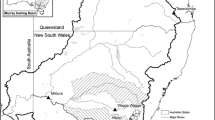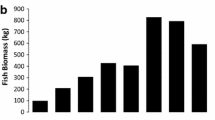Abstract
Freshwater ecosystems in many parts of the world have been severely affected by past management practices that have altered the volume, timing and quality of water flows and caused a decline in their ecological health. Some of these systems are also experiencing the negative impacts of climate change. Adaptation to climate change and the continual need to address existing ecological damage poses ongoing challenges for freshwater managers. In this paper we propose and discuss a Catchment Assessment Framework (CAF) that is used to evaluate existing and potential freshwater management actions, such as riparian revegetation and habitat connectivity, for their adaptation potential. The CAF was developed as a tool for prioritizing low risk climate change adaptation options in Australian catchment management. The CAF enables catchment managers and technical experts to assess management actions against seven inter-related criteria to provide a holistic assessment: relevance to the catchment; climate change adaptation potential, including potential for maladaptation and benefit under different climate scenarios; ecosystem service benefits; compatibility with other actions; implementation constraints; socio-economic consequences; and a risk assessment. It was developed and applied by assessing nine management options with stakeholders in three catchments within the Murray-Darling Basin in south-eastern Australia. We found that while management options are undertaken as a response to existing degradation, they can be used as building blocks for a climate change adaptation strategy that considers a range of different but complementary measures to better manage climate-related risk. The CAF enables practitioners to assess the advantages of a range of adaptation options and to subject them to their wider decision making and management planning.

Similar content being viewed by others
References
Balcombe SR, Sheldon F, Capon SJ, Bond NR, Hadwen WL, Marsh N, Bernays SJ (2011) Climate-change threats to native fish in degraded rivers and floodplains of the Murray-Darling Basin, Australia. Mar Freshw Res 62:1099–1114
Barnett J, Dovers S, Hatfield-Dodds S, McDonald J, Nelson R, Waller S (2011) National climate change adaptation research plan: social, economic and institutional dimensions. National Climate Change Adaptation Research Facility. Gold Coast, QLD, Australia
Barnett J, O’Neill S (2010) Editorial: maladaptation. Glob Environ Chang 20:211–213
Bond NR, Lake PS (2005) Ecological restoration and large-scale ecological disturbance: the effects of drought on the response by fish to a habitat restoration experiment. Restor Ecol 13:39–48
Catford JA, Naiman RJ, Chambers LE, Roberts J, Douglas M, Davies P (2012) Predicting novel riparian ecosystems in a changing climate. Ecosystems. doi:10.1007/s10021-012-9566-7
MDBA (2013) Chapter 2 – The need for reform. In: Delivering a healthy working basin: about the draft basin plan, Murray-Darling Basin Authority, Australia
Commonwealth of Australia (2011) Of drought and flooding rains: inquiry into the impact of the guide to the Murray-Darling Basin plan. House of Representatives Standing Committee on Regional Australia, Canberra
Cottingham P, Bond NR, Lake PS, Outhet D (2005) Recent lessons on river rehabilitation in eastern Australia. Cooperative Research Centre for Freshwater Ecology, Australia
CSIRO (2008) Water availability in the Murray-Darling Basin. Summary of a report to the Australian government from the CSIRO Murray-Darling Basin sustainable yields project. CSIRO, Australia
Davies PE (2010) Climate change implications for river restoration in global biodiversity hotspots. Restor Ecol 18:261–268
Docker B, Robinson I (2014) Environmental water management in Australia: experience from the Murray-Darling Basin. Int J Water Resour D 30:164--177
Döll P (2002) Impact of climate change and variability on irrigation requirements: a global perspective. Clim Chang 54:269–293
Dudley N, Stolton S, Belokurov A, Krueger L, Lopoukhine N, MacKinnon K, et al. (eds) (2010) Natural solutions: protected areas helping people cope with climate change. IUCN-WCPA, TNC, UNDP, WCS, The World Bank and WWF, New York, USA
Finlayson CM (2013) Climate change and the wise use of wetlands: information from Australian wetlands. Hydrobiologia 708:145–152
Finlayson CM, Davis JA, Gell PA, Kingsford RT, Parton KA (2013) The status of wetlandsand the predicted effects of global climate change: the situation in Australia. Aquat Sci 75:73--93
Gale M, Edwards M, Wilson L, Greig A (2014) The boomerang effect: a case study of the Murray-Darling Basin plan. Aust J Publ Admin 73:153–163
Gray DE (2004) Doing research in the real world. Sage Publications Inc, London
Hallegatte S (2009) Strategies to adapt to an uncertain climate change. Glob Environ Chang 19:240–247
Horne J (2014) The 2012 Murray-Darling Basin plan – issues to watch. Int J Water Res Dev 30:152–163
Kingsford RT (2000) Ecological impacts of dams, water diversions and river management on floodplain wetlands in Australia. Aust Ecol 25:109–127
Kingsford RT (2011) Conservation management of rivers and wetlands under climate change: a synthesis. Mar Freshw Res 62:217–222
Lawler JJ, Tear TH, Pyke C, Shaw MR, Gonzalez P, Kareiva P, et al. (2010) Resource management in a changing and uncertain climate. Front Ecol Environ 8:35–43
Lukasiewicz A, Dare L (2016) When private water rights become a public asset: stakeholder perspectives on the fairness of environmental water management. J Hydrol 536:183–191
Lukasiewicz A, Pittock J, Finlayson CM (2015) Institutional challenges of adopting ecosystem based adaptation to climate change. Reg Environ Chang. doi:10.1007/s10113-015-0765-6
Lukasiewicz A, Finlayson CM, Pittock J (2013a) Identifying low risk climate change adaptation in catchment management while avoiding unintended consequences. National Climate Change Adaptation Research Facility. Gold Coast, Australia
Lukasiewicz A, Finlayson CM, Pittock J (2013b) Incorporating climate change adaptation into catchment management: a user guide. Institute for Land, Water and Society, Albury, Australia, p. 23
Manandhar S, Pandey VP, Kazama F (2013) Climate change and adaptation: an integrated framework linking social and physical aspects in poorly-gauged regions. Clim Chang 120:727–739
Millennium Ecosystem Assessment (2003) Ecosystems and their services ecosystems and human well-being a framework for assessment. Island Press, Washington DC, USA
Nielsen DL, Brock MA (2009) Modified water regime and salinity as a consequence of climate change: prospects for wetlands of southern Australia. Clim Chang 95:523–533
NWC (2012) Water policy and climate change in Australia. National Water Commission, Canberra, Australia
O’Leary Z (2005) Researching real-world problems: a guide to methods of inquiry. Sage Publications, London, UK
Parry ML, Canziani OF, Palutikof J (eds.) (2007) Technical summary. Climate change 2007: Impacts, adaptation and vulnerability. Contribution of Working Group II to the Fourth Assessment Report of the Intergovernmental Panel on Climate Change, Cambridge University Press, Cambridge, UK
Pittock J, Williams J, Grafton Q (2015) The Murray-Darling Basin plan fails to deal adequately with climate change. Water September:26–30
Pittock J (2013) Lessons from adaptation to sustain freshwater environments in the Murray–Darling Basin, Australia. WIREs Clim Chang 4:429–438
Pittock J (2011) National climate change policies and sustainable water management: conflicts and synergies. Ecol Soc 16:25
Pittock J (2009) Lessons for climate change adaptation from better management of rivers. Clim Dev 1:194–212
Pittock J, Finlayson M (2011) Australia’s Murray-Darling Basin: freshwater ecosystem conservation options in an era of climate change. Mar Freshw Res 62:232–243
Pittock J, Hansen LJ, Abell R (2008) Running dry: freshwater biodiversity, protected areas and climate change. Roy Soc Ch 9:30–39
Pittock J, Hussey K, McGlennon S (2013) Australian climate, energy and water policies: conflicts and synergies. Aust Geogr 44:3–22
Prober SM, Thiele KR, Rundel PW, Yates CJ, Berry SL, Byrne M, et al. (2012) Facilitating adaptation of biodiversity to climate change: a conceptual framework applied to the world’s largest Mediterranean climate woodland. Clim Chang 110:227–248
Productivity Commission (2012) barriers to effective climate change adaptation. Productivity Commission Final Inquiry Report No. 59, Canberra, Australia
Reid-Piko C, Crase L, Horwitz P, Butcher R (2010) Ecosystem services and productive base for the Basin Plan, a report prepared for the Murray-Darling Basin Authority by The Murray-Darling Freshwater Research Centre. MDFRC Publication, Canberra
Shoo LP, Hoffmann AA, Garnett ST, Pressey RL, Williams YM, Taylor M, et al. (2013) Making decisions to conserve species under climate ch ange. Clim Chang 119:239–246
Swainson B, de Loë R, Kreutzwiser R (2011) Sharing water with nature: insights on environmental water allocation from a case study of the Murrumbidgee catchment, Australia. Wat Altern 4:15–34
The World Bank (2009) Convenient solutions to an inconvenient truth: ecosystem-based approaches to climate change. Environment Department, The World Bank, Washington DC, USA
Wallis PJ, Ward MB, Pittock J, Hussey K, Bamsey H, Denis A, Kenway SJ, King CW, Mushtaq S, Retamal ML, Spies BR (2014) The water impacts of climate change mitigation measures. Clim Chang 125:209–220
Author information
Authors and Affiliations
Corresponding author
Electronic supplementary material
ESM 1
(DOCX 85 kb)
Rights and permissions
About this article
Cite this article
Lukasiewicz, A., Pittock, J. & Finlayson, C.M. Are we adapting to climate change? A catchment-based adaptation assessment tool for freshwater ecosystems. Climatic Change 138, 641–654 (2016). https://doi.org/10.1007/s10584-016-1755-5
Received:
Accepted:
Published:
Issue Date:
DOI: https://doi.org/10.1007/s10584-016-1755-5




